by Benjamin Naimark-Rowse
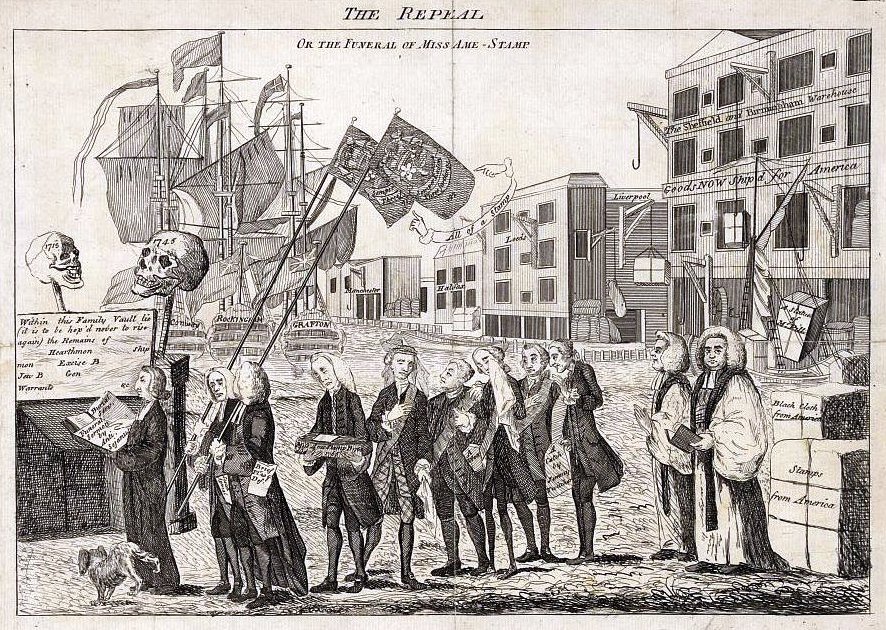
The Stamp Act repeal depicted as a 1765 funeral procession; courtesy commons.wikimedia.org
On the Fourth of July, cities and towns from coast-to-coast across the United States host fireworks, concerts, and parades to celebrate our independence from Britain. Those celebrations will invariably highlight the colonial soldiers who overcame the British. But the lessons we learn of a democracy forged in the crucible of revolutionary war tends to ignore how a decade of nonviolent resistance before the shot-heard-round-the-world (1) shaped the founding of the United States, strengthened our sense of political identity, and laid the foundation of our democracy.
Read the rest of this article »
by Rajendra Prasad
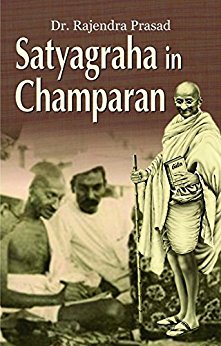
Dustwrapper art courtesy Ocean Books; oceanbooks.in
Editor’s Preface: The historical accounts of the Indian nonviolent independence movement generally focus on Mahatma Gandhi’s campaigns, whereas the Satyagraha Movement was widespread across India, with more than one leader. Rajendra Prasad (1884-1963) was one such. The account that follows draws a vivid picture of the courage and sacrifice of the campaign that Prasad led in 1930 in his home state of Bihar. His leadership qualities and commitment to nonviolence were well recognized; when India gained independence from Great Britain in 1947 he was chosen its first president. Please see our explanatory endnotes, note on the text, and editor’s note at the end of the article. JG
An outstanding example of the faith and firmness with which people acted on Mahatma Gandhi’s words was provided, in 1930, at Bihpur in Bhagalpur. (1) Bihpur is on the banks of the Ganges and is exposed to floods. The river always changes its course, as happens in all places near the Ganges. As a consequence, the boundaries marking off one man’s field from another’s are washed away, and when the floods subside, very often conflicts arise among rival claimants of land. […]
When I was touring that region in 1929, I found evidence of great enthusiasm among the people. I was convinced that when Satyagraha was started, its inhabitants would enthusiastically participate in it. I carried this impression because of an incident which occurred there. In the course of my tour, I had fixed up a meeting to be held at a particular place about two o’clock in the afternoon. I had been to another village at some distance from the place where the meeting was to be held, and had hoped to return in time for it. While I was on my way back, heavy rain came down suddenly, a strong wind began to blow, and I was delayed for two or three hours. When I arrived, soaked to the skin, I found a very big crowd which, I was told, had been awaiting my arrival in the rain for some hours. The rain itself was still falling. I stood up in the crowd in the rain and talked to them. It was this incident which impressed itself on my mind that the people of that region had courage as well as determination.
Read the rest of this article »
by Mohandas K. Gandhi
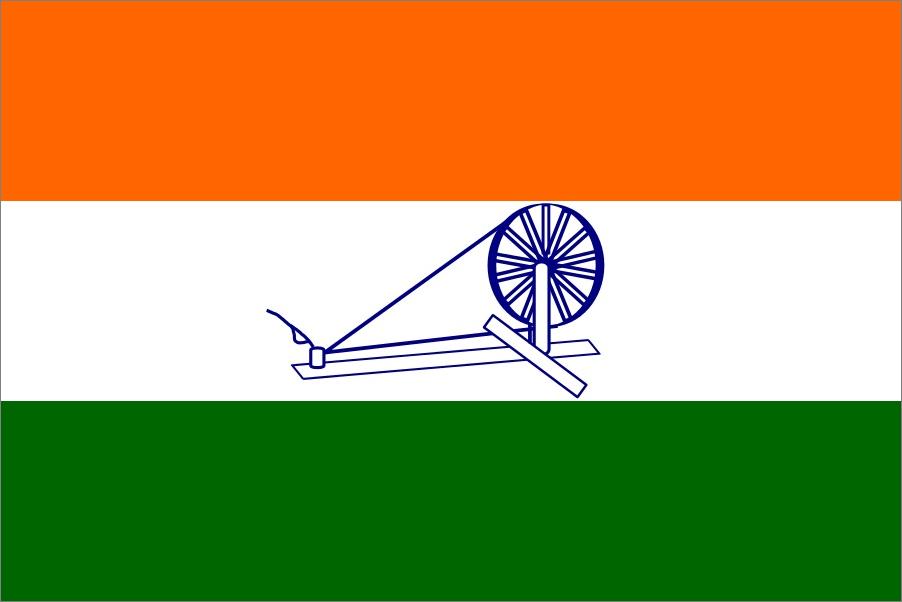
1929 proposed flag of India, with Gandhian spinning wheel; courtesy en.wikipedia.org
Editor’s Preface: The Indian National Congress formally approved “The Declaration of the Independence of India” on December 19, 1929, and it is important to understand it in its historical context. (1) Purna swaraj can be translated as “complete, sovereign independence,” that is, Indian independence from Great Britain and the ending of colonial rule. Various models had been proposed for Indian sovereignty prior to 1930, including several versions of power sharing. However, a sequence of events by the British government, violating or curtailing Indian civil rights, resounded as a betrayal to Gandhi. The “Declaration” marks a turning point in Gandhi’s thinking about Britain, and the nature of India’s future relationship with British rule. (2) There has been some disagreement as to its authorship, but Gandhi can be said to have solved the matter in February 1937 when he wrote,“ I was its author. I wanted the people not merely to repeat the mantra of independence but to educate the people as to its why and wherefore.” (3) Purna Swaraj was to be read throughout the country on January 26, 1930, and that date is still celebrated as India Independence Day. Please also see our explanatory notes at the end. JG
Purna Swaraj
We believe that it is the inalienable right of the Indian people, as of any other people, to have freedom and to enjoy the fruits of their toil and have the necessities of life, so that they may have full opportunities of growth. We believe also that if any government deprives a people of these rights and oppresses them the people have a further right to alter it or to abolish it. The British Government in India has not only deprived the Indian people of their freedom but has based itself on the exploitation of the masses, and has ruined India economically, politically, culturally, and spiritually. We believe, therefore, that India must sever the British connection and attain Purna Swaraj, or complete independence.
Read the rest of this article »
by John Dear
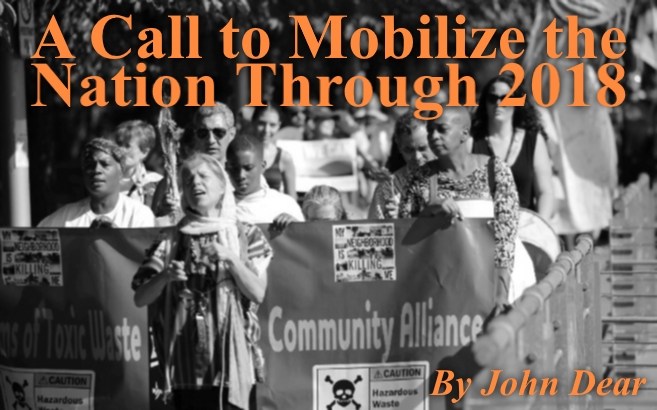
Banner illustration courtesy paceebene.org
While the media and the nation sit transfixed over the Trump scandals and attacks on democracy, those of us who work for justice and peace know that we have to keep working, resisting, and mobilizing people across the country if we are going to have the social, economic and political transformation we need for our survival.
In other words, we’ve only just begun. Instead of giving up, giving in, or throwing in the towel, instead of sitting glued to the tube, we’re going forward. The campaign for a new culture of nonviolence is on!
Read the rest of this article »
by War Resisters League
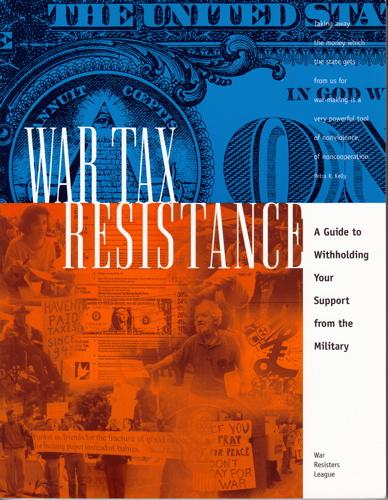
Dustwrapper art courtesy www.warresisters.org
Refusing to pay taxes for war is probably as old as the first taxes levied for warfare. We offer below a summary of such protest, which is to say it does not include other forms of tax refusal and resistance, a common tactic in worldwide labor movements, for example, or in various anti-colonial protests including such well-known examples as the Boston Tea Party.
Indeed, until World War II, war tax resistance in the U.S. manifested itself primarily among members of the historic peace churches — Quakers, Mennonites, and Brethren — and usually only during times of war. There have been instances of people refusing to pay taxes for war in virtually every American war, but it was not until World War II and the establishment of a permanent, centralized U.S. military (symbolized by the building of the Pentagon) that the modern war tax resistance movement was born.
Colonial America
One of the earliest known instances of war tax refusal took place in 1637 when the relatively peaceable Algonquin Indians opposed taxation by the Dutch to help improve their local Fort Amsterdam. Shortly after the Quakers arrived in America (1656) there were a number of individual instances of war tax resistance. For example, in 1709 the Quaker Assembly refused a request of £4000 for a military expedition into Canada, replying, “It is contrary to our religious principles to hire men to kill one another.”
Read the rest of this article »
by David Gross
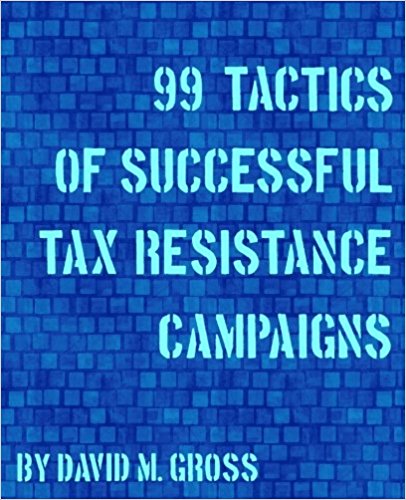
Dustwrapper art courtesy David Gross; sniggle.net/TPL/index5.php
Editor’s Preface: This article was written in March 2003 as a response to the U.S. invasion of Iraq. David Gross went on to become a leading figure in the tax resistance movement. Please see his compilation of John Woolman’s writings, previously posted here, and see also the note at the end for further information, acknowledgments, and links. JG
When the war in Iraq started, [March 20, 2003] and especially when it escalated into a full-blown invasion, I gave notice at work. My intention was to reduce my income below the threshold of taxation so as to stop paying income tax to the U.S. government. I’m writing this to explain myself to my friends, who will notice a bit of a change of lifestyle in me in the coming months. Also, I write because writing calms my nerves, and I’m a bit nervous about this. I’m starting on an experiment, and I’m not sure where it will take me.
I take on faith the philosophical speculation that each of us has free will. It does seem that a lot of the evidence lately has been going in the other direction, but that doesn’t stop me. If I’m right, I have the opportunity to try my hand at the controls. If I’m wrong, I couldn’t change my mind if I wanted to, no?
Read the rest of this article »
by David Gross
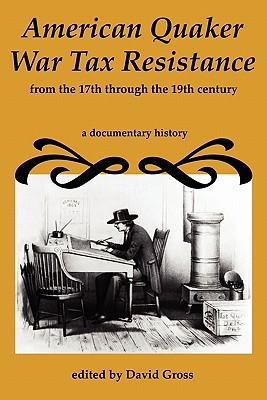
Dustwrapper art courtesy David Gross; sniggle.net/TPL/index5.php
Editor’s Preface: Tax resistance is one of the oldest nonviolent tactics, some citing a Jewish Zealot Revolt of c. 60-70 CE as the first. We are inaugurating our new series on the subject with this article about the 18th century Quaker, John Woolman. His call to conscience was one of the more influential texts on early American civil disobedience and resistance. If anything tax resistance is now not only more relevant, but more prevalent. We are posting two versions of John Woolman’s tax resistance writings; the first reproduces the original journal entries, and retains, therefore, Woolman’s spelling and grammar, with exceptions in square brackets. The second, Harvard Classics version, modernizes the language. JG
The American Quaker John Woolman (1720-1772) was a pioneer of conscientious tax resistance, and he has left a record of how he wrestled with his conscience over whether or not to pay taxes for the French and Indian War. (1) As he wrote, “To refuse the active payment of a Tax which our Society generally paid, was exceedingly disagreeable; but to do a thing contrary to my Conscience appeared yet more dreadfull . . . I knew of none under the like difficulty, and in my distress I besought the Lord to enable me to give up all, that so I might follow him wheresoever he was pleased to lead me.” (2)
Read the rest of this article »
by Robert Levering
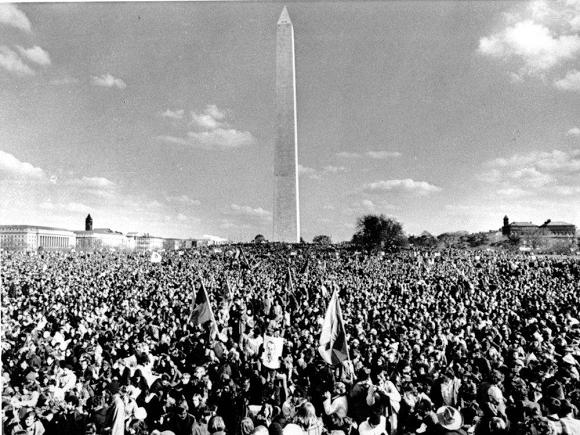
Anti-Vietnam War rally at Washington Monument, Nov. 1969; courtesy npr.org
Only the Vietnam era protests match the size and breadth of the movement unleashed by the election of Donald Trump. One point of comparison: The massive march and rally against the Vietnam War in 1969 was the largest political demonstration in American history until the even more massive Women’s March on January 23. All around us we can see signs that the movement has only just begun. Consider, for instance, that a large percentage of those in the Women’s March engaged in their very first street protest. Or that thousands of protesters spontaneously flocked to airports to challenge the anti-Muslim ban. Or that hundreds of citizens have confronted their local congressional representatives at their offices and town hall meetings about the potential repeal of Obamacare and other Trump/Republican policies.
Read the rest of this article »
by Dyllan Taxman
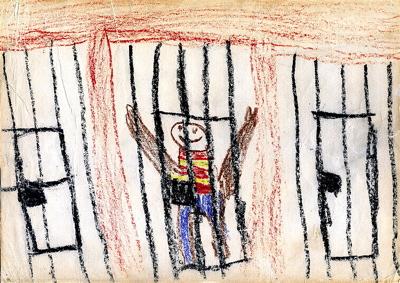
A drawing of Jim Forest in prison made by his son Ben, age six at the time, for his Sunday School class.
Editor’s Preface: Dyllan Taxman, an 8th grade student in Milwaukee, Wisconsin, was doing a research project for his history class and decided to look into an act of civil disobedience that had taken place in his city in September 1968. As Jim Forest has written, “The Vietnam War was raging. A group of fourteen people broke into nine draft boards that had offices side by side in a Milwaukee office building, put the main files into burlap bags, then burned the papers with homemade napalm in a small park in front of the office building while reading aloud from the Gospel. We awaited arrest, were jailed for a month, freed on bail, then tried the following year, after which we went to prison for more than a year; for most of us it was 13 months.” The interview was conducted in February 2006. Please see the note at the end for further information. JG
Dyllan Taxman: What made you do this?
Jim Forest: I had been in the military myself so didn’t have to worry about the draft, but as a draft counselor (a big part of my work with the Catholic Peace Fellowship) I was painfully aware of how thousands of young people were being forced to do military service in an unjust war about which they knew little or nothing, or even opposed. Anyone who knew the conditions for a just war could see this war did not qualify.
Read the rest of this article »
by Jim Forest
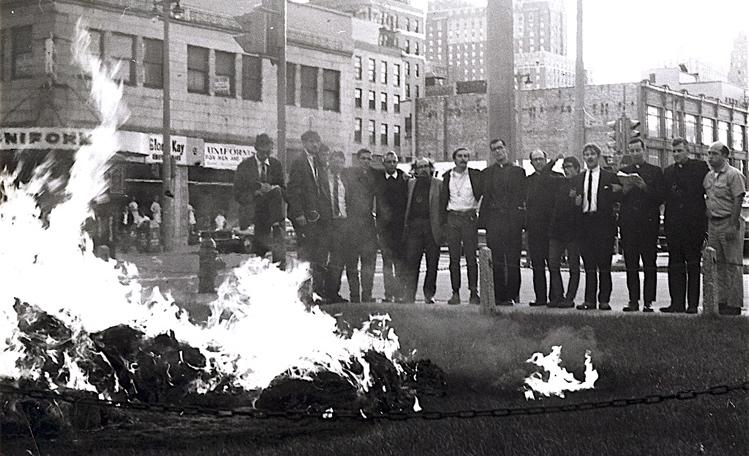
Photograph of the Milwaukee 14 courtesy Jim Forest; details at the end of the article.
Editor’s Preface: Tactics define a protest, whether violent or nonviolent. They have been and are a matter of controversy and heated discussion within movements, as in the recent Occupy. Indeed, some would define nonviolence as a tactic, a definition not accepted by all. In the Catonsville Nine and the Milwaukee 14 protests the burning of draft files was seen by some as a justified means towards ending the Vietnam War, while others such as Dorothy Day and Thomas Merton saw it, at the very least, as a dangerous blurring of the line between violence and nonviolence. Jim Forest is here adding his word to this debate. We have also posted other articles concerning the definition of nonviolent tactics, especially Dorothy Day’s famous article, “Dan Berrigan in Rochester”, and the book review at this link of a recent history of the Catonsville Nine, which quotes Merton’s famous warning. JG
I was one of the Milwaukee 14, a group that burned draft records in 1968. This was the action that followed the Catonsville Nine. The discussion of Plowshares-style property damage and destruction in the November issue of The Catholic Agitator really got me thinking. One of the essential elements in property destruction actions is secrecy. If you tell them you’re coming, they won’t let you in. It’s that simple. The only way around it is to take pains not to be expected. You are obliged to be secretive. There are events in life where secrecy is necessary, even contexts in which life-saving actions are difficult or even impossible unless there is secrecy. For example here in Holland, my home since 1977, you had to be highly secretive about the people you were hiding during the period of German occupation.
Read the rest of this article »














